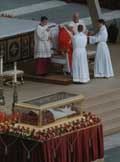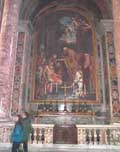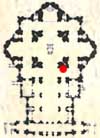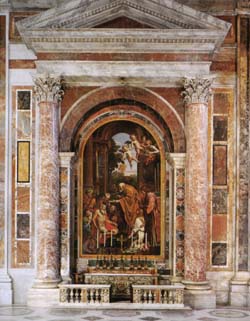| Grottoes
Vatican City Colonnade Saints Floorplan #2 |
| Altars
Monuments The History |
| Related
Sites St. Jerome Pope John XXIII |
|
Under the Altar of St. Jerome is the resting site for the body of Bl. John XXIII. The original canvas altarpiece of the Last Communion of St Jerome is now in the Vatican Picture Gallery |
 |
| |
 |
 |
From:
'St. Peter's - Guide to Basilica and Square'
Returning to the aisle, against the pier supporting the dome we find the
Altar of St. Jerome decorated with a mosaic reproduction of Domenichino's
famous painting of the Last communion of St. Jerome. Next to the 93-year
old saint, St. Paul can be seen bending to kiss his hand; and a lion,
its paws tucked under it, looks almost as if it were participating in
his deep sorrow (the original canvas is in the Vatican Picture Gallery).
At this point we note that most o the pictures in the basilica are mosaics,
many of which are the work of P. Cristofari (whose preparatory cartoons
can be found in various museums and churches).
From:
'St. Peter's Basilica - A Virtual Tour' by Our
Sunday Visitor
Leaving this side aisle, we find ourselves in front of the St. Jerome
Altar, situated at the back of the front right hand pier. On it is the
large altarpiece transformed into a mosaic in 1744 from the famous painting
by Domenichino dated 1614 and now hanging in the Vatican Pinacoteca. The
artist painted the 90 year old Saint nude, almost dying, receiving the
last Communion from St. Ephrem, with the help of the Roman matron St.
Paula.
From: 'Guide to
St Peter's Basilica' © 2003, Libreria
Editrice Vaticana
The altar of St Jerome closes the right-side aisle, as it is set at the
back of the pier of St Longinus. Since 2nd June 2001 it had been dedicated
to the Blessed John XXIII. Over it is the altarpiece with the Last Communion
of St Jerome, a mosaic copy realized in 1730 after the famous painting
by Domenichino, nowadays kept in the Pinacoteca Vaticana. Beneath the
altar is the body of Blessed Pope John XXIII, here transferred on 4th
June 2001. The four gilt bronze bas-reliefs were made by Novello Finotti,
who represented two moments in John's pontificate: the II Vatican Council
and UT UNUM SINT and two encyclicals MATER ET MAGISTRA and PACEM IN TERRIS.
The Body of John
XXIII
VATICAN, Mar. 27, 01 (CWNews.com) - With visible emotion, Cardinal Virgilio
Noe, archpriest of St. Peter's basilica, has noted that the body of Pope
Bl. John XXIII, who died in 1963 and was beatified on September 3, 2000
by Pope John Paul II, has remained incorrupt.
"It is a providential coincidence, a sign of divine favor and of holiness," he said today during a meeting with reporters about his book, "Tombs and Monuments of St. Peter's and the Vatican."
On January 16, in the presence of Cardinal Angelo Sodano, Secretary of State of the Holy See, Bishop Leonardo Sandri, and Cardinal Noe, the tomb of John XXIII was opened for the recognition of his mortal remains which will be transferred from the Vatican crypt (located under the basilica) into the basilica itself. After only one-half day of work, the witnesses could see the face of John XXIII, " intact and serene," said Cardinal Noe, who also revealed "the emotion" which seized them at the opening of the tomb.
By tradition, Popes are buried in three containers. John XXIII's body was in a cypress coffin, which was placed in a lead catafalque, known as "castrumdoloris," which in turn was deposited in a travertine marble sarcophagus.
Pope John Paul had decided on the transfer to the basilica, as a mark of the holiness of John XXIII. "It was not easy to find a place in the basilica where we can build the new tomb for John XXIII," said the cardinal. Indeed, it was necessary that this place be accessible at the same time to the faithful, who will want to venerate the blessed, and out of the way of the crowds which come daily to visit the basilica. The choice was made for the St. Jerome crypt, located on the line of the central span, not far from the statue of St. Peter. John XXIII, a specialist in the fathers of the Church, was devoted to St. Jerome.
Blessed John XXIII will join the 47 other popes who rest in the basilica during a "liturgical ceremony," which should take place in the next few months. Among these popes is Boniface VIII, who died in 1303 and whose body was also found incorrupt in 1605.
For approximately twelve centuries, the basilica and the Vatican crypt have been a place of burial for the popes, in order to perpetuate the memory of Peter, apostle and first pope. The forms of crypts are very diverse, from the sarcophagus of the earliest days to crypts of contemporary art (like those of Pius XI or Pius XII) including those grand examples from the Renaissance and the Baroque period.
From:
'THE NEW SAINT PETER'S'
Above the altar at the end of the aisle we see a mosaic copy of the famous
painting by Domenichino (1581-1641), the Viaticum of Saint Jerome. The
aged saint receives communion from Saint Ephrem in the monastery of Bethlehem.
Kneeling in the act of kissing the hand of the dying man is the profile
of Saint Paula of Rome, one of the great Biblical scholar's favourite
disciples.


